|
The Beacon at the Summit:
messages from Cornwall in the summer of 2021
Benjamin
Hallo
For months, G7 Cornwall had promised spectacle. Hosted this year from
the 11th to the 13th of June in Carbis Bay, the meeting of leaders from
seven of the world’s wealthiest liberal democracies came at a time of
increasing public anger at inaction on issues of climate change and
structural racism, and during a period of pandemic and global economic
insecurity. I was told that senior police officers were expecting to
make 200 arrests a day over the weekend as protestors tried to ‘send a
message’, with large amounts of disruption to transport and daily life
in Cornwall.
While thousands of protestors from Cornwall and elsewhere did take to
the streets in protest, and a large cruise ship full of police docked in
Falmouth, the anticipated clashes and disorder failed to transpire. As
was the case for the G8 summit in Northern Ireland in 2013, the threat
of disruption from protest now appears overstated – the largest amount
of disruption coming, instead, from preparations for the event itself.
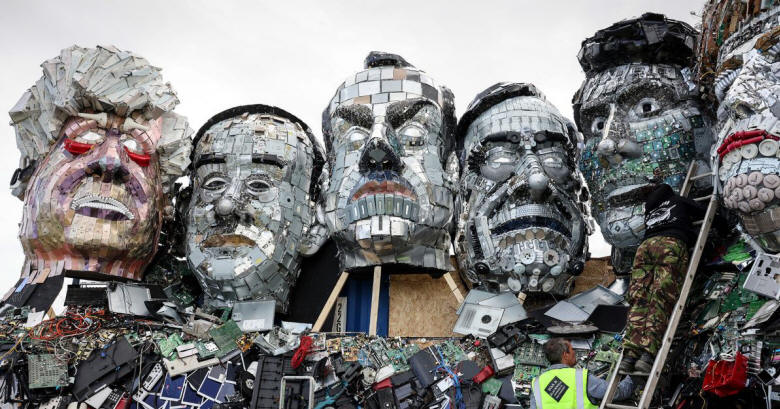 'Mount Recyclemore' at Hayle Towans
'Mount Recyclemore' at Hayle Towans
The anticipated message-sending vehicle of
direct action was replaced with a theatre of artistic expression at this
year’s G7, with displays aiming to bring attention to campaigns of
global and local change. Joe Rush’s ‘Mount Recyclemore’ at Hayle Towans
focused on the issue of electronic waste; Tête à Tête used instruments
made from reclaimed plastics to create a ‘Song of the Sea’ which they
hoped would bring attention to plastic pollution in Cornwall as across
the world; Extinction Rebellion (XR) put together numerous artistic
efforts involving music, dance, and theatre; families and individuals in
St Ives, Carbis Bay, and Falmouth hung banners from their windows,
detailing what it was they hoped the G7 leaders would concentrate on;
one front garden in Falmouth was even converted into a Doomsday
graveyard – ‘TICK TOCK’, written in the window, with headstones for
‘buried hope’ and the future victims of nuclear war, among others.
There is, of course, a long tradition of collective artistic
performances in response to events like these – the ‘marching turtles’
of the 1999 WTO Ministerial Conference, and the ‘puppetistas’ who
emerged in the early 2000s are two examples which spring to mind – it
would be wrong to suggest a form of Cornish exceptionalism in this
regard. Nonetheless, such performances as played out across the streets,
cliffs, and beaches of Cornwall this June represent the multifarious
attempts of activists to make their positions known at the G7 summit of
2021. Such attempts should, I think, constitute our lasting images of
the event.
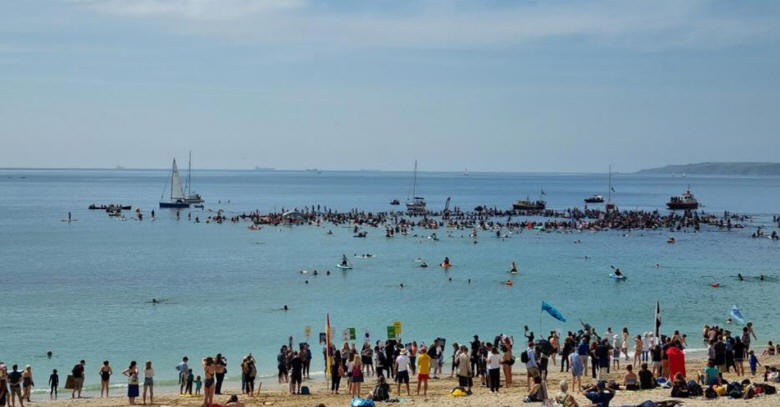
Surfers Against Sewage ‘paddle-out’, Saturday 12th June
2021 (photograph by author)
Much of the performance and demonstration
was suffused with a sense of collective joy. Activists of all ages
paddled-out on boards, floats, kayaks, and an inflatable shark at
Gyllyngvase Beach to make a statement about the ocean and climate crisis
on the Saturday morning (above). Many of the hundreds involved remained
afterwards to swim, sunbathe, and talk – to enjoy themselves! It was
moving to see such collective action and pleasure after so much social
isolation.
There were also displays of anger and pain: veiled-people pushing empty
‘ghost’ prams through the streets in memory of the child victims of
climate crisis; a moment’s silence in Falmouth followed by a
call-and-response for the historic victims of Cornwall’s mining
industry; a huge sand-sketch in Newquay calling on world leaders to
‘share the vaccine [and] waive the patents’. There was a poignant
eclecticism about the performances of the weekend.
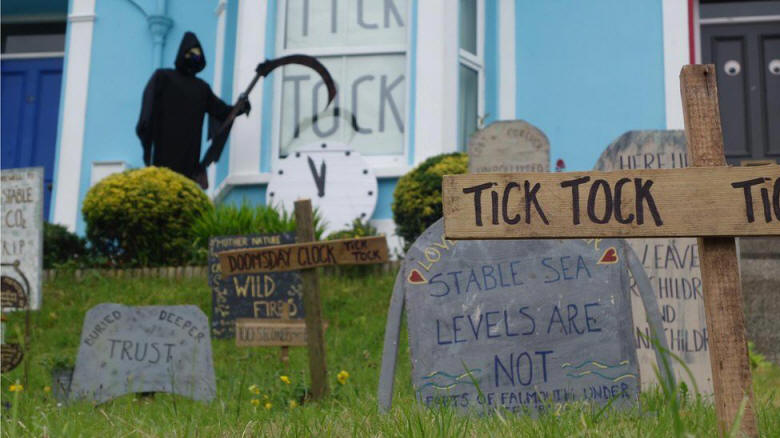 Doomsday graveyard, Falmouth
Doomsday graveyard, Falmouth
Yet, it would be wrong to suggest everyone
was in support of the banners, sculpture, music, and dance which greeted
the G7 summit. I encountered an argument between two local men about a
large demonstration moving past them. One saw protest as characteristic
of all the things now wrong with his home, the other saw such action as
the only way of repairing it. While in obvious conflict over the types
of problem which need addressing in Cornwall, and the methods by which
change in this sense might be achieved, such a confrontation belies a
significant commonality between the two parties – a sense of a home
being eroded, polluted, lost.
Many I spoke to over the G7 weekend felt Cornwall had changed over their
lifetimes. This feeling seems ever-present here – that, by one force or
another, ‘our Cornwall’ is becoming ‘their Cornwall’ (to borrow a binary
used by C. C. Vyvyan in 1948) – that ‘home’ is being lost, whether to
community division and protest, pollution, second home ownership, or an
influx of ‘outsiders’. Combined with this is a sense that the voices of
‘locals’ are not being heard.
Unrelated to the G7, physical signs of
tension have been created along the roads and paths of Cornwall this
summer: ‘Tourists Go Home’; ‘No More 2nd Homes’; ‘Respect Malpas […] If
Not, Bugger Off’. The worry of ‘our Cornwall’ being lost appears clearer
this year than most, with the fear and anger of some permanent Cornish
residents written on the streets.
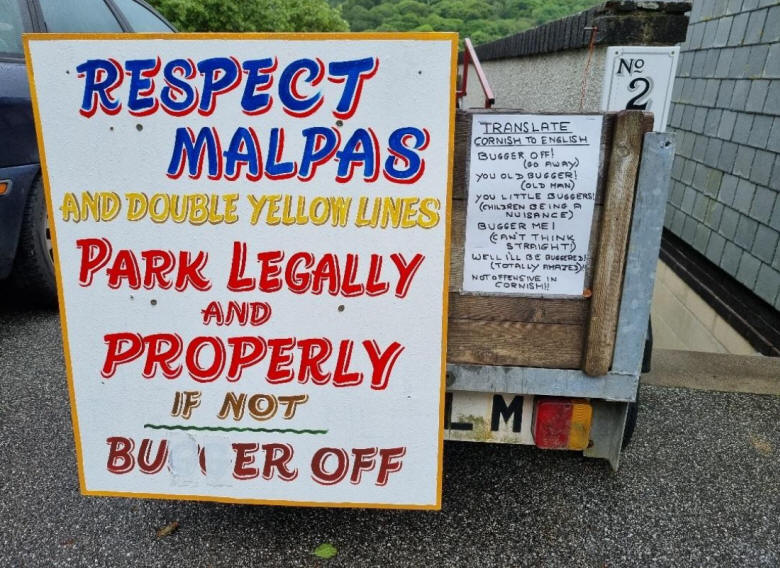
A Message in Malpas, Truro, July 2021 (photograph by
author)
'Behind the Postcard', a short film created
by a large collective of writers, community groups, and performers for
the G7 weekend, focused on the contiguity between beauty, worry,
poverty, and pleasure in Cornwall. Significantly, this place is depicted
as a real one, with all the diversity of life experience found across
modern Britain. Yet, again, the sentiment of sending messages and being
heard is clear - blasted in the film’s outro song, the words, “listen to
our clarion call, don’t just admire the view!”
The film itself is wide-ranging and open as voices enter and exit,
weaving more layers into a poetic description of every-day life in
Kernow. Again, in these woven strands, an appreciation of place
(understandably) sits alongside a fear of loss in the face of perceived
insecurity. Most lasting for me is a short line spoken by Jowan Jacobs,
“I hope this hedge is safe.”
The very eclecticism of responses to the G7 is representative of the
heterogeneity of Cornwall and its people. Such a display renders any
idea of a homogenous rural community, opposed to those in the cities,
laughable. Major disruption by protestors upon local people before the
summit were unrealised – perhaps fears of such were unfounded. Instead,
what I have witnessed this summer – more than most – is mobilisation by
local people to bring focus upon the various issues which matter to
them, and to indicate the solutions they see fit.
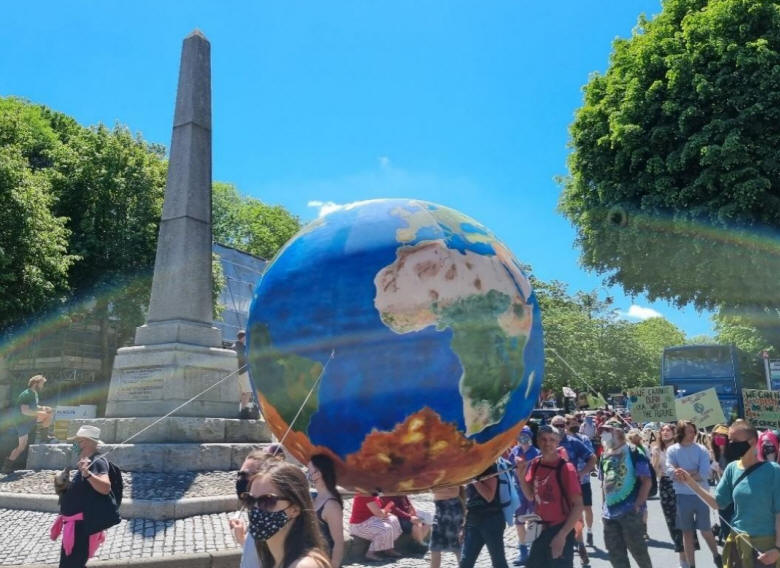
Home? Falmouth June 12th, 2021 (photograph by author)
There have been no riots on the streets of Cornwall this summer – no
great events of disruption and disorder – but there are people trying to
be heard, wanting change and making it known. Amid the tangle of issues
and experiences, what that change should entail is (as usual) contested.
Yet, within the mish-mash of creatively conveyed messages in Cornwall
this summer – on signs in gardens and windows, shouted at protests,
written on roads, walls, and paths – is a shared desire to protect ‘our
home’.
With this in mind, and as we battle local and global crises, it makes
sense to ask: 'whose (who's) home, and who’s listening?'
also see
https://www.screencornwall.com/behindthepostcard
Christie van Tinteren is a PhD
candidate at the University of Cambridge
7.8.21 |





